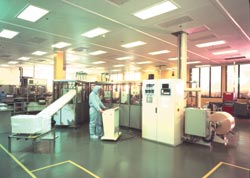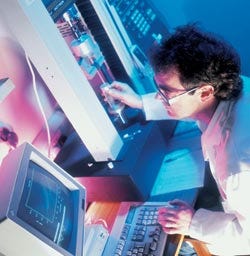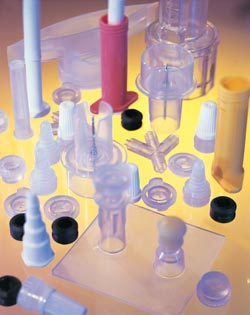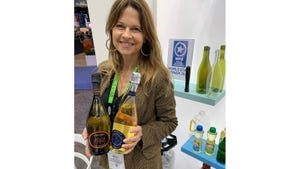IMM’s Plant Tour: Meeting the demands of medical OEMs
December 6, 2002
|
Medisize Donegal HealthCare’s two-building complex in Letterkenny, Ireland was purpose-built in 1981 to make plastic molded medical and pharmaceutical products under strict cleanroom conditions. The northwest corner of Ireland has a high percentage of that country’s many health care manufacturing facilities. |
Medisize Donegal HealthCare (MDHC) has overcome more than a few bumps in the road to get where it is today. Since its founding 21 years ago, MDHC has had four different corporate identities. Yet it never strayed from what it is now—a strategic partner to pharmaceutical and medical device companies for development, industrialization, and manufacturing of plastic medical devices and drug packaging.
The fact that MDHC was founded as a health care company, and did not slowly develop into one, is a definite advantage, according to Brian McGarvey, who is involved in strategy and marketing at the company’s headquarters in the northwest corner of Ireland. Its only business focus over the last 21 years has been in health care, which has enabled MDHC to position itself as the full development and production partner that pharmaceutical and medical device companies now demand.
|
MDHC looks to automation for quality and productivity, but it reserves the investment for applications where it makes sense. This custom system makes multichambered intravenous bags that incorporate molded parts. All manufacturing and packaging is within Class 10,000 cleanrooms. |
A Positive Progression
The medical and pharmaceutical industry has undergone substantial corporate merging in the last 10 to 15 years. The entity that is now MDHC was founded in 1981 by U.S.-based Imed Corp. as a manufacturing facility for its intravenous systems and as an entry point into European markets. (Imed merged with Ivac Medical Systems in 1996 to form Alaris Medical Systems of San Diego, CA.)
In 1994 the company was acquired by Pharmacia AB of Sweden, which, after mergers first with Upjohn and subsequently with Monsanto and Searle, is destined to be acquired by Pfizer by the end of this year.
|
The “weak welds†developed by MDHC to separate the three compartments in the intravenous bags shown upper left and upper right keep the drugs segregated until ready for use. Rolling the envelopes, which are assembled in the system shown, top, breaks the welds and mixes the components for use. |
The MDHC facility IMM visited in Letterkenny, County Donegal was purpose-built to handle molding, assembly, sterilization, and packaging of medical products under strict cleanroom conditions. It is still producing advanced intravenous systems. The company already had strong medical production credentials when it joined Pharmacia. However, it was Pharmacia that established the in-house development department that enabled the company to position itself as a full strategic partner, instead of solely as a contract manufacturer.
When Pharmacia changed its direction, Donegal HealthCare emerged as an independent company in February 1999 through a buyout by five of its managers. In late June of this year, managing director Joe Gilmartin announced that the company agreed to be acquired by the medical business group of Swiss-based Gurit Heberlein AG, which owned the Medisize brand. With the acquisition, Gurit’s health care division now comprises MDHC, Medisize BV in the Netherlands, and Medisize CZ in the Czech Republic.
Medisize Donegal HealthCare |
The three Medisize companies are complementary. MDHC is strong in intravenous systems and devices. Medisize BV has in-depth expertise in respiratory and inhalation systems technology, and more. The company in the Czech Republic provides a lower-labor-cost destination for assembly-intensive products, an important factor in any production equation these days.
The acquisition of MDHC by Gurit parallels what is happening in the company’s customer markets, namely globalization and strategic realignment, says McGarvey. It also provides a greater resource base than a company MDHC’s size (2001 turnover of nearly $18 million) can offer alone. In what it describes as a year of transition, Gurit expects turnover in 2002 to reach about $285 million.
Made for Medical Business
MDHC’s project engineer Des Mulligan, one of the five managers who bought the company in 1999, says he believed then in the capability of MDHC and is just as positive about it today. Like McGarvey, he emphasizes the company’s expertise provided by its employees. Medical and pharmaceutical companies, he says, are not simply looking to outsource the mechanical production of their products. They want real product development knowledge and creative intelligence. That, he says, is what MDHC has been building all these years, and the tour proved it.
|
Many of the molds used here are complex, multicavity tools, more often than not with hot runners. Most molds are purchased from Irish moldmakers, while some more specialized technologies are bought elsewhere in Europe. |
The MDHC facility consists of two buildings comprising 83,000 sq ft. Of this, 55,000 sq ft is manufacturing; the rest is warehouse space for finished goods and raw materials. The development department works almost totally in 3-D CAD using AutoCAD and Pro/Engineer. Its employees include well-trained process engineers and design specialists. Ireland’s technical schools and universities, such as those at Athlone, Dublin, and Sligo, have had well-developed programs in place for years. The skill level is high and goes a long way toward explaining the cluster of world-class medical companies that have made Ireland, particularly its northwest section, their operations bases for Europe and beyond.
|
Intravenous systems were this company’s first product line when it was an in-house production facility of a U.S. company. As a strategic development and production partner to health care OEMs, it continues to stay at the leading edge of IV technology. |
Mulligan says a lot of time, skill, and effort goes into process validation at MDHC. The company’s goal is for the mold to run as it should when it starts up, or as close to that as possible. Once validated, a process is rigorously monitored, as are the machines and auxiliaries involved. Validation is based on a particular mold on a particular machine. If the mold must go to another machine, the validation process is done anew. Before press validation, FEMA and moldfilling simulations are standard. MDHC began a cooperative use of Moldflow software about 10 years ago with one of its moldmakers, Avenue Mould of Sligo. Its use led to notably better startups and has since become standard.
The injection molding areas contain 22 machines ranging from 15 to 250 tons. Eleven of them are from Demag Ergotech, seven are tiebarless systems from Engel, and the others are from Krauss-Maffei and Arburg. Material feeding is handled from a central system and some machines have additional drying hoppers to ensure that material has not taken on water between the central system and the machine.
Molding technologies include two-component processing (two machines presently and another coming soon) and insert molding in vertical and horizontal presses. As we passed an empty space on the floor, Mulligan said that would be home to MDHC’s newest technology, liquid injection molding (LIM) of silicone. The machine, which is coming from Battenfeld, will be up and running before the end of this year. The first application, a tip for a diagnostic system, is in the latter stages of development.
|
MDHC’s labs are set up to assist in development and performance testing of their customers’ products as well as to test incoming raw material, molded parts, and final assemblies. |
Automation Must Justify Itself
Most of the injection machines are automated, at least for part removal and sprue cutting, and some systems are full production cells. MDHC is generally in favor of automation for repeatability and precise quality monitoring, Mulligan says, but the process and the production volume have to justify it. The same attitude pertains to the company’s assembly operations. They are automated as volume and complexity dictate. Startup projects are almost always done manually. The automation is subsequently designed around the process.
A similar job-oriented approach is taken with the molding machines. Mulligan says there is no preset machine replacement policy. About half of MDHC’s current machines are less than five years old, and some are as old as 14 years. The only requirement is that a machine does the job(s) it is meant to do. MDHC is always on the lookout for an advantage, and the tiebarless Engel machines are a good example. Mulligan cites a project running on one of them in which the mold configuration and robotics dictate a press of around 140 tons. The process requires far less clamp force, so a 40-ton Engel system is molding the job at a nice savings in cost and floor space.
|
Because press-side assembly and other downstream operations can disturb cleanroom conditions, it is done only when the benefit is high. In one system, MDHC is doing pad printing in a production cell, and carefully monitoring the area. |
All molding and assembly operations are done in positive-pressure, Class 10,000 cleanrooms. The actual cleanliness levels are better than that to provide a safety margin. All production machinery is fully inside the cleanroom and only sealed packages exit.
MDHC drew on the best source possible to establish its cleanroom procedures: its medical-pharmaceutical customers. Mulligan says the procedures in place cover not only how people enter and leave the cleanroom, but also how they actually move while working within the cleanroom. To those not in the medical business, this might seem overdone, but a contaminated product could put a life at risk.
Assembly has been one of MDHC’s strengths, but the company is now concentrating on the more complex and critical assemblies and the high-volume projects that lend themselves to automation. An excellent example of how the company combines its assembly, design, development, and materials knowledge is well evidenced in a three-chambered intravenous pouch. In it, three drugs must be kept segregated until just before use, and then they must be easily mixed with no possible contamination. MDHC developed a design using what it calls “weak welds.†When needed, the bag is rolled in a specified direction that breaks the welds dividing the pouches and mixes the ingredients.
|
Process validation is supported by FEMA and computer simulation testing before production and by thoroughly running it on the machine. Parts are carefully inspected during production to ensure compliance to specs and tolerances. |
MDHC came up with the design, the materials, the welding technology, and the assembly automation. It buys special three-layer film and uses a rotary table to weld in the filling and feeding valves molded in-house. After the weak welds are made, the bag is sent to the marketing company for filling. As Mulligan says with a smile, a lot of drop testing went into that one.
Success Through Partnership
To be a strategic development and manufacturing partner with medical companies takes a lot more than molding skill. MDHC has a range of sterilization technology that includes ETO, e-beam, and even gamma sterilization. The latter involves a highly automated safe containment environment with walls 7 ft thick consisting of a 22-ft-deep water pool.
Then there is the issue of quality. Everyone is thoroughly and regularly trained in good manufacturing practices. The plant is certified ISO 9001/EN 46001 for design and manufacturing, and has ISO 14001 environmental certification. Since the company markets to the U.S. medical market, it is also FDA-registered.
|
The clear needle sleeves shown at center and upper right are a tricky bit of insert molding. The needles, which are pointed at both ends, must be precisely aligned. They are robotically inserted in vertical and horizontal molding presses and a sealing gasket is molded around them in a two-material sequence. |
The strides MDHC has taken to partner with its OEM customers have paid off. Both Mulligan and McGarvey say the outsourcing trend continues to grow in the medical business. OEM companies have the knowledge and skills to see what is needed in the market; they do not want to worry about or invest in processing. OEMs have gained confidence that their suppliers know more about how the product is made than they do.
Both men stress that no projects are outsourced if development is not included. Medical companies insist on it, and want it under the same roof as manufacturing to simplify management. Above all, OEMs want the quality they demand of themselves. This, says McGarvey, is where MDHC shines.
Contact information |
You May Also Like











